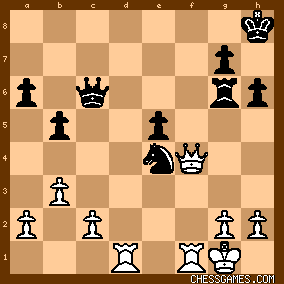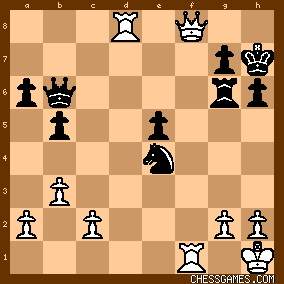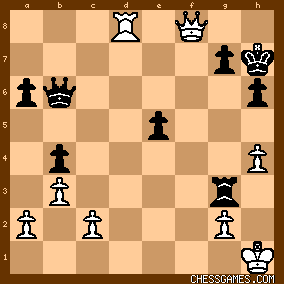KEG: Post III
Although Pillsbury had a won game after 27...Qc7, his play from here--as throughout the game--remained spotty and uncharacteristically careless. As will be seen, he gave Rosen chances to get back into the game; chances which Rosen did not exploit on his way to defeat. 28. Qf4
Weak play that almost allowed Rosen to launch the desperate attack he may have hoped his ill-conceived exchange sacrifice on move 23 was going to generate. Much better here was 28. b4 or even 28. Qd4.
28... Re6
29. Nd4
Yet again failing to play 29. b4. Also better than the text were 29. Ng3 or 29. a3. 29... Rg6
30. NxB QxN
31. Nf3 Nxe4
32. NxN dxN
Rosen has made some small progress. He has won back a pawn and has some counterplay. The position was now: 
click for larger viewDespite some second-best moves by Pillsbury, he still seems to have the game in hand. But now: 33. Rd8+?
A severely flawed attempt to build a mating net. Suddenly, Rosen has chances. Pillsbury should have played 33. Rf3.
33... Kh7
34. Qf8 Qb6+
35. Kh1
This left:

click for larger viewPillsbury is threatening mate on the move, but Rosen would have had chances with the simple 35...Rf6. After 36. RxR NxR. Instead: 35... Rg5?
This allowed Pillsbury to chase the Black King to destruction with 36. Qg8+ or 36. Qh8+. But--yet again in this game--Pillsbury missed his chances with: 36. Rf3?
This allowed Rosen a chance to play 36...Nf6 and hang on for a while. But... 36... b4??
Now Pillsbury again can rule the board with 37. Re8 (and get his Rook off d8 where it is attacked by Rosen's Queen, or to play 37. h4
Perhaps not as strong as 37. Re8, but this move is consistent with Pillsbury's style of striving for mating lines. Unlike Pillsbury's last few moves, this time the threats are for real, and the game is over. 37... Ng3+
37...Rh5 was probably better, but there was no hope for Rosen now. 38. RxN
There were other ways to win, but this method is cute. 38... RxR
The position was now:

click for larger viewRosen has restored material equality, but now he must give up his Queen to avoid mate. 39. h5!
A beautiful move, that (finally) cinches victory for Pillsbury. 39... QxR
40. QxQ e4
41. Qe8 Rg4
42. Kg1
42. Qe5 was even better, but this move was more than sufficient. 1-0 | 




































